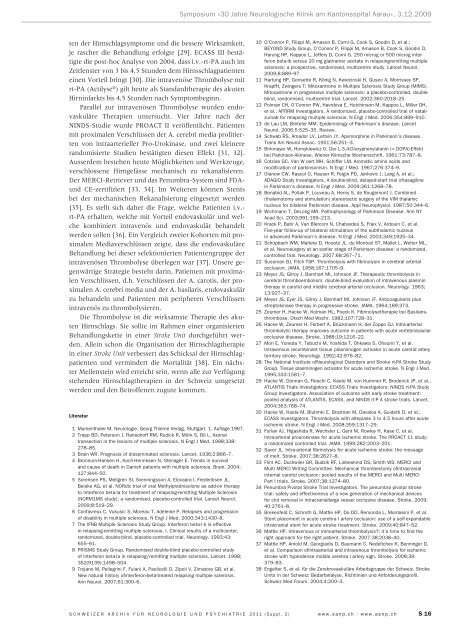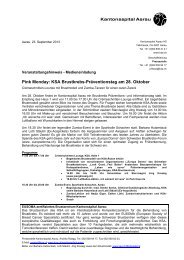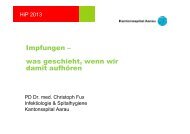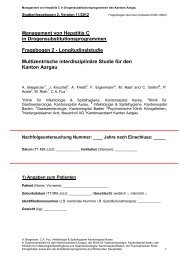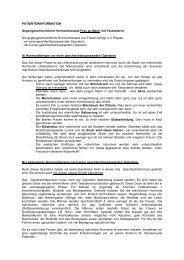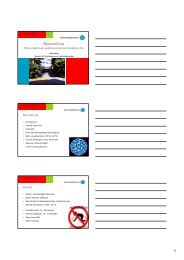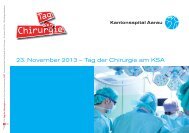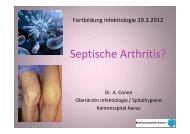SANP - Supplementum Vol. 162 | Suppl. 2 - Kantonsspital Aarau
SANP - Supplementum Vol. 162 | Suppl. 2 - Kantonsspital Aarau
SANP - Supplementum Vol. 162 | Suppl. 2 - Kantonsspital Aarau
Sie wollen auch ein ePaper? Erhöhen Sie die Reichweite Ihrer Titel.
YUMPU macht aus Druck-PDFs automatisch weboptimierte ePaper, die Google liebt.
ten der Hirnschlagsymptome und die bessere Wirksamkeit,<br />
je rascher die Behandlung erfolgte [29]. ECASS III bestätigte<br />
die posthoc Analyse von 2004, dass i.v.rtPA auch im<br />
Zeitfenster von 3 bis 4,5 Stunden dem Hirnsschlagpatienten<br />
einen Vorteil bringt [30]. Die intravenöse Thrombolyse mit<br />
rtPA (Actilyse ® ) gilt heute als Standardtherapie des akuten<br />
Hirninfarkts bis 4,5 Stunden nach Symptombeginn.<br />
Parallel zur intravenösen Thrombolyse wurden endovaskuläre<br />
Therapien untersucht. Vier Jahre nach der<br />
NINDSStudie wurde PROACT II veröffentlicht. Patienten<br />
mit proximalen Verschlüssen der A. cerebri media profitierten<br />
von intraarterieller ProUrokinase, und zwei kleinere<br />
randomisierte Studien bestätigten diesen Effekt [31, 32].<br />
Ausserdem bestehen heute Möglichkeiten und Werkzeuge,<br />
verschlossene Hirngefässe mechanisch zu rekanalisieren.<br />
Der MERCIRetriever und das PenumbraSystem sind FDA<br />
und CEzertifiziert [33, 34]. Im Weiteren können Stents<br />
bei der mechanischen Rekanalisierung eingesetzt werden<br />
[35]. Es stellt sich daher die Frage, welche Patienten i.v.<br />
rtPA erhalten, welche mit Vorteil endovaskulär und welche<br />
kombiniert intravenös und endovaskulär behandelt<br />
werden sollen [36]. Ein Vergleich zweier Kohorten mit proximalen<br />
Mediaverschlüssen zeigte, dass die endovaskuläre<br />
Behandlung bei dieser selektionierten Patientengruppe der<br />
intra venösen Thrombolyse überlegen war [37]. Unsere gegenwärtige<br />
Strategie besteht darin, Patienten mit proximalen<br />
Verschlüssen, d.h. Verschlüssen der A. carotis, der proximalen<br />
A. cerebri media und der A. basilaris, endovaskulär<br />
zu behandeln und Patienten mit peripheren Verschlüssen<br />
intra venös zu thrombolysieren.<br />
Die Thrombolyse ist die wirksamste Therapie des akuten<br />
Hirnschlags. Sie sollte im Rahmen einer organisierten<br />
Behandlungskette in einer Stroke Unit durchgeführt werden.<br />
Allein schon die Organisation der Hirnschlagtherapie<br />
in einer Stroke Unit verbessert das Schicksal der Hirnschlagpatienten<br />
und vermindert die Mortalität [38]. Ein nächster<br />
Meilenstein wird erreicht sein, wenn alle zur Verfügung<br />
stehenden Hirnschlagtherapien in der Schweiz umgesetzt<br />
werden und den Betroffenen zugute kommen.<br />
Literatur<br />
1 Mumenthaler M. Neurologie. Georg Thieme Verlag, Stuttgart. 1. Auflage 1967.<br />
2 Trapp BD, Peterson J, Ransohoff RM, Rudick R, Mörk S, Bö L. Axonal<br />
transection in the lesions of multiple sclerosis. N Engl J Med. 1998;338:<br />
278–85.<br />
3 Brain WR. Prognosis of disseminated sclerosis. Lancet. 1936;2:866–7.<br />
4 Bronnum-Hansen H, Koch-Henriksen N, Stenager E. Trends in survival<br />
and cause of death in Danish patients with multiple sclerosis. Brain. 2004;<br />
127:844–50.<br />
5 Sorensen PS, Mellgren SI, Svenningsson A, Elovaara I, Frederiksen JL,<br />
Beiske AG, et al. NORdic trial of oral Methylprednisolone as add-on therapy<br />
to Interferon beta-la for treatment of relapsing-remitting Multiple Sclerosis<br />
(NORM1MS study): a randomised, placebo-controlled trial. Lancet Neurol.<br />
2009;8:519–29.<br />
6 Confavreux C, Vukusic S, Moreau T, Adeleine P. Relapses and progression<br />
of disability in multiple sclerosis. N Engl J Med. 2000;343:1430–8.<br />
7 The IFNB Multiple Sclerosis Study Group. Interferon beta-l b is effective<br />
in relapsing-remitting multiple sclerosis. I. Clinical results of a multicenter,<br />
randomized, double-blind, placebo-controlled trial. Neurology. 1993;43:<br />
655–61.<br />
8 PRISMS Study Group. Randomised double-blind placebo-controlled study<br />
of interferon beta-la in relapsing/remitting multiple sclerosis. Lancet. 1998;<br />
352(9139):1498–504.<br />
9 Trojano M, Pellegrini F, Fuiani A, Paolicelli D, Zipoli V, Zimatore GB, et al.<br />
New natural history ofinterferon-beta-treated relapsing multiple sclerosis.<br />
Ann Neurol. 2007;61:300–6.<br />
Symposium «30 Jahre Neurologische Klinik am <strong>Kantonsspital</strong> <strong>Aarau</strong>», 3.12.2009<br />
10 O’Connor P, Filippi M, Arnason B, Corni G, Cook S, Goodin D, et al.;<br />
BEYOND Study Group, O’Connor P, Filippi M, Amason B, Cook S, Goodin D,<br />
Harung HP, Kappos L, Jeffery D, Corni G. 250 microg or 500 microg interferon<br />
beta-lb versus 20 mg glatiramer acetate in relapsingremitting multiple<br />
sclerosis: a prospective, randomised, multicentre study. Lancet Neurol.<br />
2009;8:889–97.<br />
11 Hartung HP, Gonsette R, König N, Kwiecinski H, Guseo A, Morrissey SP,<br />
KrapfH, Zwingers T; Mitoxantrone in Multiple Sclerosis Study Group (MIMS).<br />
Mitoxantrone in progressive multiple sclerosis: a placebo-controlled, doubleblind,<br />
randomised, multicentre trial. Lancet. 2002;360:2018–25.<br />
12 Polman CH, O’Connor PW, Havrdova E, Hutchinson M, Kappos L, Miller DH,<br />
et al.; AFFIRM Investigators. A randomized, placebo-controlled trial of natalizumab<br />
for relapsing multiple sclerosis. N Engl J Med. 2006;354:899–910.<br />
13 de Lau LM, Breteler MM. Epidemiology of Parkinson’s disease. Lancet<br />
Neurol. 2006;5:525–35. Review.<br />
14 Schwab RS, Amador LV, Lettvin JY. Apomorphine in Parkinson’s disease.<br />
Trans Am Neurol Assoc. 1951;56:251–3.<br />
15 Birkmayer W, Homykiewicz O. Der L-3,4-Dioxyphenylalanin (= DOPA)-Effekt<br />
bei Parkinson-Akinese. Wiener Klinische Wochenschrift. 1961;73:787–8.<br />
16 Cotzias GC, Van W oert MH, Schiffer LM. Aromatic amino acids and<br />
modification of parkinsonism. N Engl J Med. 1967;276:374–9.<br />
17 Olanow CW, Rascol O, Hauser R, Feigin PD, Jankovic J, Lang A, et al.;<br />
ADAGIO Study Investigators. A double-blind, delayed-start trial ofrasagiline<br />
in Parkinson’s disease. N Engl J Med. 2009;361:1268–78.<br />
18 Benabid AL, Pollak P, Louveau A, Henry S, de Rougemont J. Combined<br />
(thalamotomy and stimulation) stereotactic surgery of the VIM thalamic<br />
nucleus for bilateral Parkinson disease. Appl Neurophysiol. 1987;50:344–6.<br />
19 Wichmann T, DeLong MR. Pathophysiology of Parkinson Disease. Ann NY<br />
Acad Sci. 2003;991:199–213.<br />
20 Krack P, Batir A, Van Blercom N, Chabardes S, Fraix V, Ardouin C, et al.<br />
Five-year follow-up of bilateral stimulation of the subthalamic nucleus<br />
in advanced Parkinson’s disease. N Engl J Med. 2003;349:1925–34.<br />
21 Schüpbach WM, Maltete D, Houeto JL, du Montcel ST, Mallet L, Welter ML,<br />
et al. Neurosurgery at an earlier stage of Parkinson disease: a randomized,<br />
controlled trial. Neurology. 2007;68:267–71.<br />
22 Sussman BJ, Fitch TSP. Thrombolysis with fibrinolysin in cerebral arterial<br />
occlusion. JAMA. 1958;167:1705–9.<br />
23 Meyer JS, Gilroy J, Barnhart MI, Johnson JF. Therapeutic thrombolysis in<br />
cerebral thromboembolism: double-blind evaluation of intravenous plasmin<br />
therapy in carotid and middle cerebral arterial occlusion. Neurology. 1963;<br />
13:927–37.<br />
24 Meyer JS, Eyer JS, Gilroy J, Barnhart MI, Johnson JF. Anticoagulants plus<br />
streptokinase therapy in progressive stroke. JAMA. 1964;189:373.<br />
25 Zeumer H, Hacke W, Kolman HL, Poeck K. Fibrinolysetherapie bei Basilaristhrombose.<br />
Dtsch Med Wschr. 1982;107:728–31.<br />
26 Hacke W, Zeumer H, Ferbert A, Brückmann H, deI Zoppo GJ. Intra-arterial<br />
thrombolytic therapy improves outcome in patients with acute vertebrobasilar<br />
occlusive disease. Stroke. 1988;19:1216–22.<br />
27 Mori E, Yoneda Y, Tabuchi M, Yoshida T, Ohkawa S, Ohsumi Y, et al.<br />
Intravenous recombinant tissue plasminogen activator in acute carotid artery<br />
territory stroke. Neurology. 1992;42:976–82.<br />
28 The National Institute ofNeurological Disorders and Stroke rt-PA Stroke Study<br />
Group. Tissue plasminogen activator for acute ischemic stroke. N Engl J Med.<br />
1995;333:1581–7.<br />
29 Hacke W, Donnan G, Fieschi C, Kaste M, von Kummer R, Broderick JP, et al.;<br />
ATLANTIS Trials Investigators; ECASS Trials Investigators; NINDS rt-PA Study<br />
Group Investigators. Association of outcome with early stroke treatment:<br />
pooled analysis of ATLANTIS, ECASS, and NINDS rt-P A stroke trials. Lancet.<br />
2004;363:768–74.<br />
30 Hacke W, Kaste M, Bluhmki E, Brozman M, Davalos A, Guidetti D, et al.;<br />
ECASS Investigators. Thrombolysis with altepiase 3 to 4.5 hours after acute<br />
ischemic stroke. N Engl J Med. 2008;359:1317–29.<br />
31 Furlan AJ, Higashida R, Wechsler L, Gent M, Rowley H, Kase C, et al.<br />
Intra-arterial prourokinase for acute ischemic stroke. The PROACT 11 study:<br />
a randomized controlled trial. JAMA. 1999;282:2003–201.<br />
32 Saver JL. Intra-arterial fibrinolysis for acute ischemic stroke: the message<br />
of melt. Stroke. 2007;38:2627–8.<br />
33 Flint AC, Duckwiler GR, Budzik RF, Liebeskind DS, Smith WS; MERCI and<br />
Multi MERCI Writing Committee. Mechanical thrombectomy ofintracranial<br />
internal carotid occlusion: pooled results of the MERCI and Multi MERCI<br />
Part I trials. Stroke. 2007;38:1274–80.<br />
34 Penumbra Pivotal Stroke Trial Investigators. The penumbra pivotal stroke<br />
trial: safety and effectiveness of a new generation of mechanical devices<br />
for clot removal in intracraniallarge vessel occlusive disease. Stroke. 2009;<br />
40:2761–8.<br />
35 Brekenfeld C, Schroth G, Mattle HP, Do DD, Remonda L, Mordasini P, et al.<br />
Stent placement in acute cerebra I artery occlusion: use of a self-expandable<br />
intracranial stent for acute stroke treatment. Stroke. 2009;40:847–52.<br />
36 Mattle HP. Intravenous or intra-arterial thrombolysis?: it’s time to find the<br />
right approach for the right patient. Stroke. 2007;38:2038–40.<br />
37 Mattle HP, Amold M, Georgiadis D, Baumann C, Nedeltchev K, Benninger D,<br />
et al. Comparison ofintraarterial and intravenous thrombo lysis for ischemic<br />
stroke with hyperdense middle cerebra I artery sign. Stroke. 2008;39:<br />
379–83.<br />
38 Engelter S, et al. für die Zerebrovaskuläre Arbeitsgruppe der Schweiz. Stroke<br />
Units in der Schweiz: Bedarfanalyse, Richtlinien und Anforderungsprofil.<br />
Schweiz Med Forum. 2004;4:200–3.<br />
S C H W E I Z E R A R C H I V F Ü R N E U R O L O G I E U N D P S Y C H I A T R I E 2 0 1 1 ( S u p p l . 2 ) w w w . s a n p . c h | w w w . a s n p . c h<br />
S 16


